
The Osprey class was a Royal Navy class of screw-driven sloops built between 1874 and 1877. Nine additional ships were built to a revised design, the Doterel-class sloop. They were the first class of ship in the Royal Navy to use glass scuttles.

HMS Vixen was an armoured composite gunboat, the only ship of her class, and the third ship of the Royal Navy to bear the name. She was the first Royal Navy vessel to have twin propellers.

The Fantome class was a six-ship class of 4-gun screw composite sloops built for the Royal Navy during 1873 and 1874.

The Algerine-class gunboats were a class of six 3-gun wooden gunboats built for the Royal Navy in 1857. A further pair were built in India for the Bombay Marine in 1859.

The Vigilant-class gunvessel of the Royal Navy was an enlarged version of the Arrow-class gunvessel of 1854. Both classes were designed for shallow-water operations in the Baltic and Black Seas during the Crimean War. Fourteen of the class were completed, but were ready too late to take part in that conflict. Cormorant was sunk in action at the Taku Forts, Osprey was wrecked on the coast of Africa in 1867 and the rest were all sold during the 1860s, with Sparrowhawk lasting until 1872.

HMS Wasp was a Banterer-class composite screw gunboat of the Royal Navy, built in 1880 by Barrow Iron Shipbuilding and wrecked off Tory Island in 1884.
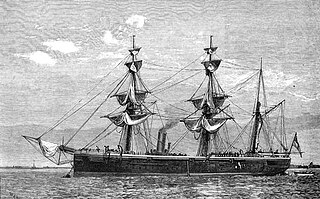
The Doterel class was a Royal Navy class of screw-driven sloops. They were of composite construction, with wooden hulls over an iron frame. They were a revised version of an 1874 design by the Royal Navy's Chief Constructor, William Henry White, the Osprey-class sloop. Two of the class were lost, one to an explosion off Chile and one wrecked off Canada. Gannet is preserved at Chatham Historic Dockyard.

The Sharpshooter-class torpedo gunboat was a class of torpedo gunboat built for the Royal Navy in the late 19th century. One of the class was hulked in 1904, seven were scrapped before World War I and five were converted to minesweepers. Of these minesweepers, Seagull was lost to a collision in 1918 and the rest survived the war to be broken up in the early 1920s.

HMS Swinger was an Ariel-class composite gunboat of the Royal Navy, built at Pembroke Dockyard and launched on 7 February 1872. She served at first on the China Station and from 1883 on the Australia Station. She was hulked in 1895 sold for breaking in 1924.

The Ariel-class gunboat was a class of nine 4-gun composite gunboats built for the Royal Navy between 1871 and 1873. Although most were sold by 1890, one of them survived into the 1920s as a salvage vessel in private ownership. They were the first class of Royal Navy gunboat built of composite construction, that is, with iron keel, stem and stern posts, and iron framing, but planked with wood.
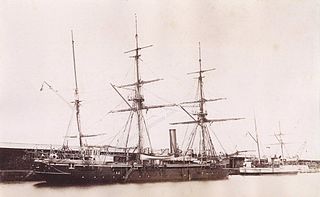
The Algerine-class gunvessel was a class of three Royal Navy composite gunvessels built in 1880. Two of them were sold after only ten years of service, but the other was converted to a survey ship before commissioning and survived in this role until 1907.
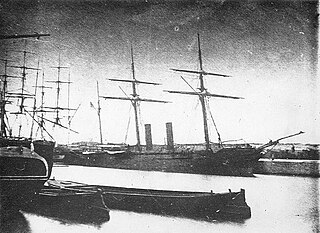
Intrepid-class gunvessels were a class of six Royal Navy first-class wooden gunvessels built in 1855-56. They were rated as sloops from 1859 to 1862, and were scrapped by 1865. Victor was sold to the Confederate States of America as the raider CSS Rappahannock, but she was interned by the French at Calais and never fulfilled her intended function.

HMS Jaseur was an Algerine-class gunboat launched in 1857. She served on the North America and West Indies station for less than two years before her loss by stranding on the Bajo Nuevo Bank in the Caribbean on 26 February 1859.
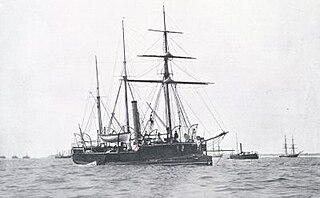
The Medina-class gunboat was a class of 12 Royal Navy Rendel gunboats mounting three 6.3-inch guns, built between 1876 and 1877. Flat-iron gunboats were normally built without masts or rigging, but the Medinas carried a full barquentine rig. Their robust iron hulls meant that they lingered on as diving tenders, barges and lighters, with five of them working into the 1920s. The hull of Medway lies in shallow water in Bermuda and is visible on satellite imagery.
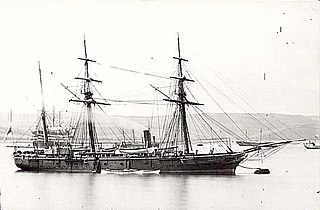
The Arab-class gunvessels were a pair of composite gunboats built for the Royal Navy in the mid-1870s.

The Banterer-class gunboat was a class of eleven gunboats mounting two 6-inch and two 4-inch guns, built for the Royal Navy between 1880 and 1892.

The Britomart-class gunboat was a class of sixteen gunboats built for the Royal Navy in 1859–1867.

The Bramble-class gunboat was a class of four gunboats mounting six 4-inch guns, built for the Royal Navy in 1886. In 1887 the first three were reclassified as gunvessels.

The Albacore-class gunboat was a class of three gunboats built for the Royal Navy in 1883. The name had already been used for a class of 98 gunboats built during the Great Armament of the Crimean War.
The Bulldog-class steam vessels (SV2) later reclassed as First Class Sloops, were designed by Sir William Symonds, the Surveyor of the Navy. Designed from the Driver class by Admiralty Order of 26 December 1843, the design was approved in 1844. The changes included lengthening the bow by 10 feet to provide 6 feet of extra space in the engine room. Three vessels would have a single funnel whereas Scourge would have two and be completed as a bomb vessel. In July 1844 it was queried if Fury was to be completed as a screw vessel, however, since her construction was well along she would be completed as a paddle steamer. Four vessels were ordered and completed.

















